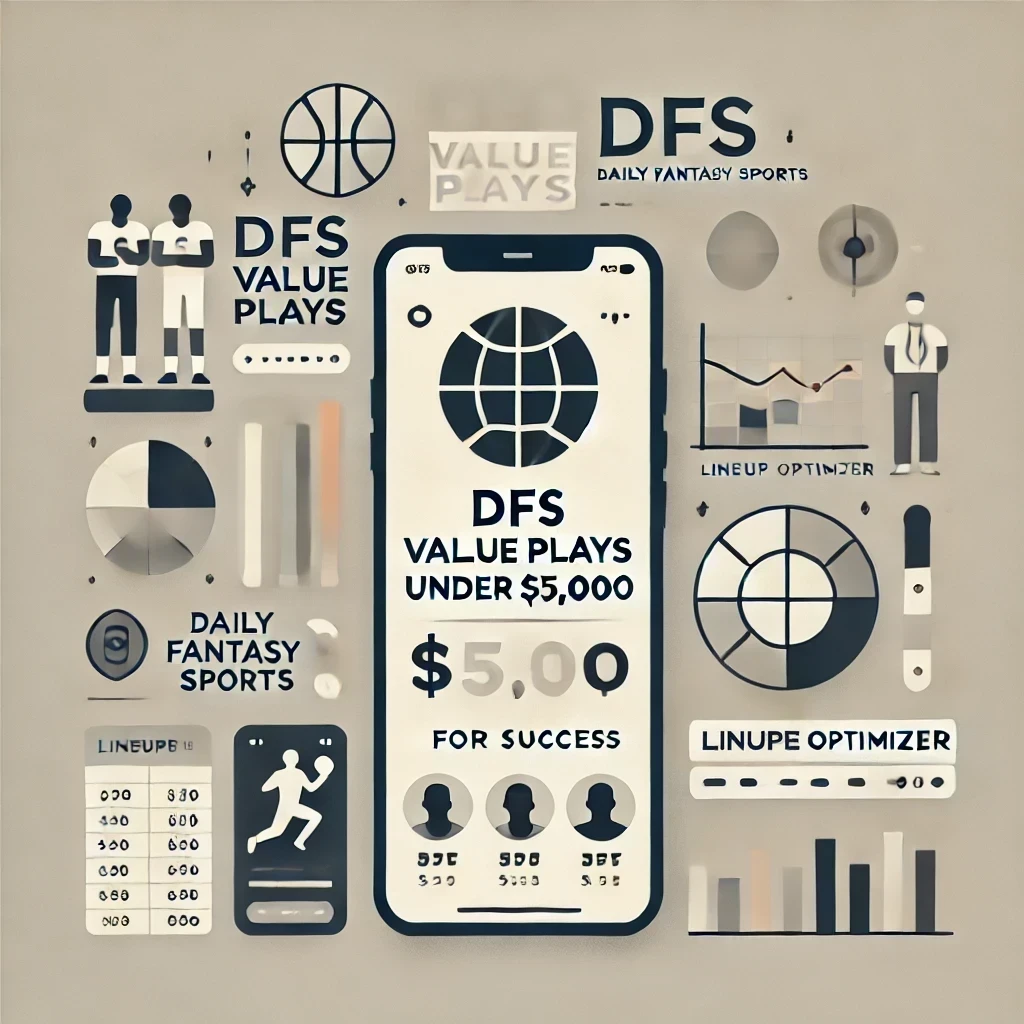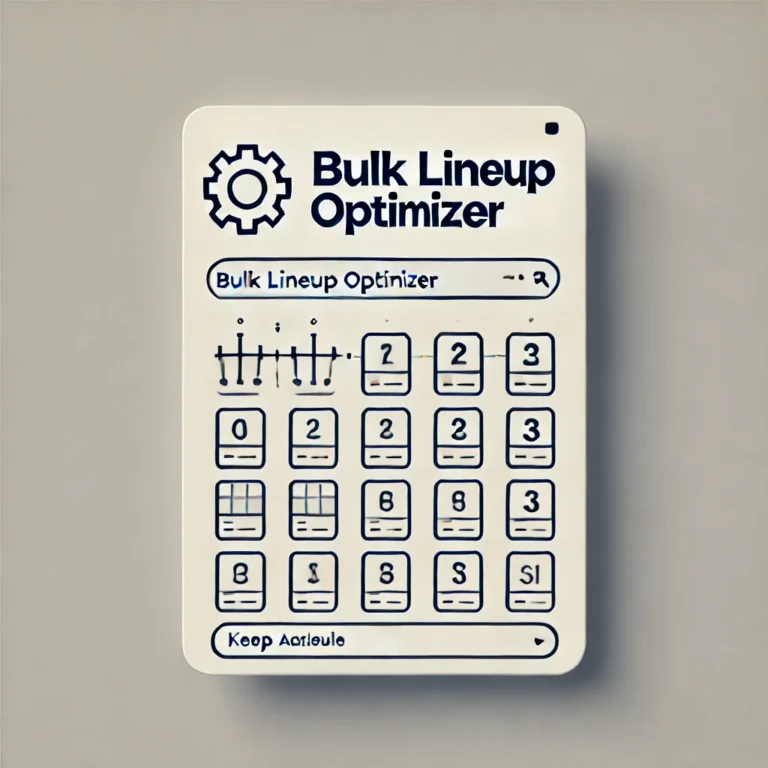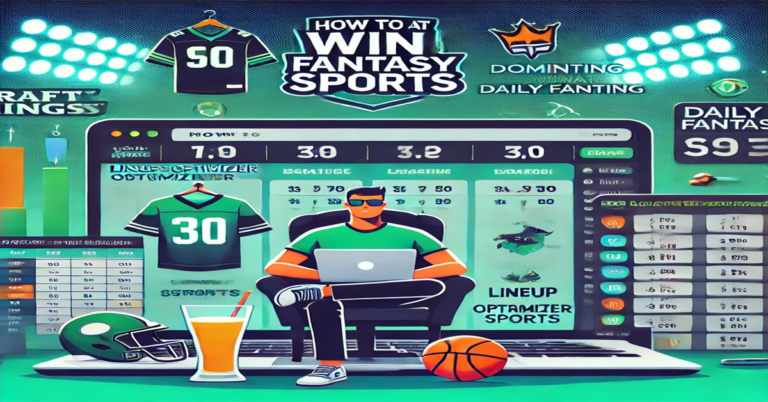DFS Value Plays Under $5,000: Ultimate Guide for Success
Introduction to DFS Value Plays
Daily Fantasy Sports (DFS) has taken the sports world by storm, offering an exciting way to test your skills and intuition in picking the best players for a variety of sports. One of the most important strategies in DFS is identifying value plays. These are players who are priced lower than the elite tier but have the potential to deliver performance well above their cost. Finding DFS value plays under $5,000 is especially critical because it allows you to maximize your salary cap, allowing for the inclusion of higher-priced stars in your lineup.
This article will serve as a comprehensive guide to understanding, identifying, and capitalizing on DFS value plays under $5,000. We will cover everything from what value plays are, how to find them, and how to use them effectively in sports like NFL, NBA, and MLB. Additionally, we will explore tools, strategies, and case studies to help you master this essential DFS tactic.
Table of Contents
- What Are DFS Value Plays?
- Importance of DFS Value Plays Under $5,000
- How to Identify DFS Value Plays
- Statistical Analysis
- Injury Reports
- Game Matchups
- Player Usage and Snap Counts
- DFS Value Plays in Different Sports
- NFL Value Plays
- NBA Value Plays
- MLB Value Plays
- Best Tools for Finding DFS Value Plays
- Lineup Optimizers
- Projection Models
- DFS Aggregators
- Strategies for Using DFS Value Plays in Tournaments
- Balancing Value Plays with Stars in Cash Games
- Risks and Rewards of Relying on Value Plays
- DFS Value Plays for NFL Under $5,000: Key Examples
- Quarterbacks
- Running Backs
- Wide Receivers
- Tight Ends
- DFS Value Plays for NBA Under $5,000: Key Examples
- Point Guards
- Shooting Guards
- Small Forwards
- Power Forwards
- Centers
- DFS Value Plays for MLB Under $5,000: Key Examples
- Pitchers
- Infielders
- Outfielders
- Advanced Metrics to Consider When Selecting Value Plays
- Usage Rate (NBA)
- Target Share (NFL)
- Expected Runs (MLB)
- How Injury Reports Impact DFS Value Plays
- Game Script and Its Impact on Value Plays
- Weather Considerations in DFS for Outdoor Sports
- Stacking and Correlation with DFS Value Plays
- Player Projections and Floor vs. Ceiling
- Understanding Ownership Percentage and Leverage
- Common Mistakes to Avoid with DFS Value Plays
- Case Study: Successful DFS Lineup Using Value Plays
- DFS Value Plays Under $5,000 in Single-Game Slates
- Final Thoughts: Maximizing Your DFS Success with Value Plays
1. What Are DFS Value Plays?
DFS value plays refer to players who are priced lower than top-tier athletes but offer significant upside for their price. These players are typically priced under $5,000 in DFS contests on platforms like DraftKings and FanDuel. The aim is to find players who can outscore their salary by a wide margin, offering a solid return on investment (ROI).
For instance, a wide receiver priced at $4,500 who scores 15 fantasy points offers a better ROI than a star receiver priced at $9,000 scoring 25 points. DFS value plays are key to building balanced lineups that feature both top-tier talent and solid budget options.
2. Importance of DFS Value Plays Under $5,000
Why are DFS value plays so important? Because they provide the flexibility to spend more on high-ceiling players. Whether you’re playing in cash games or large GPP (Guaranteed Prize Pool) tournaments, finding players under $5,000 who can perform above their price tag is vital to building optimal lineups.
Key Benefits:
- Salary Cap Flexibility: Allows you to afford top-tier players while maintaining balance across positions.
- Contrarian Strategy: Value plays often have lower ownership, which can provide leverage in large tournaments.
- High ROI Potential: The right value play can greatly exceed expectations, giving you an edge over the competition.
3. How to Identify DFS Value Plays
Identifying DFS value plays under $5,000 requires a mix of statistical analysis, research, and intuition. Here are the top factors to consider:
Statistical Analysis
Understanding player stats is essential. Look for players who may be underperforming relative to their potential, or those in a position to take advantage of a favorable matchup.
- For NFL: Look at snap counts, target shares, and red zone opportunities.
- For NBA: Usage rate, minutes played, and shooting efficiency are critical.
- For MLB: Batting order, pitcher matchups, and ballpark factors can make all the difference.
Injury Reports
Injuries play a huge role in DFS value plays. A player who moves up the depth chart due to an injury can suddenly become a fantastic value under $5,000.
Game Matchups
Pay attention to matchups. For example, an NFL running back going up against a defense ranked poorly in rush defense presents a high upside. In the NBA, a center playing against a team with poor rebounding metrics might offer great value.
Player Usage and Snap Counts
Understanding how often a player is on the field or court is crucial. A wide receiver who is consistently playing 80% of snaps and seeing targets, but is priced under $5,000, could be a strong value play. Similarly, an NBA bench player who is slated for increased minutes could provide exceptional value.
4. DFS Value Plays in Different Sports
Each sport offers unique opportunities for finding value plays. Let’s explore DFS value plays under $5,000 across the NFL, NBA, and MLB.
NFL Value Plays
In the NFL, finding value plays under $5,000 usually revolves around injuries, depth chart movement, and game script. A running back filling in for an injured starter, or a wide receiver thrust into a starting role due to an injury, are classic value plays.
NBA Value Plays
In the NBA, value plays often emerge when starters are rested or injured. A backup point guard might see extended minutes, or a young player might get more usage when a veteran is out. These factors can lead to value plays that far exceed their DFS price.
MLB Value Plays
In MLB, value plays tend to revolve around favorable matchups with opposing pitchers. A player with a good track record against a certain pitcher, or one who thrives in hitter-friendly parks, can provide excellent value for their price.
5. Best Tools for Finding DFS Value Plays
Several tools can help you find DFS value plays under $5,000. Here are some of the most effective:
Lineup Optimizers
Lineup optimizers, like Draft Dashboard, FantasyLabs or RotoGrinders, allow you to input specific constraints, such as salary cap limits, and generate optimal lineups. These tools are particularly useful for uncovering value plays.
Projection Models
Projection models use advanced algorithms to estimate player performance based on historical data, matchups, and other factors. These models often highlight undervalued players priced under $5,000.
DFS Aggregators
DFS aggregators pull data from multiple projection models and betting markets, helping you to quickly identify which value plays are most popular and which might be flying under the radar.
6. Strategies for Using DFS Value Plays in Tournaments
In GPP tournaments, finding low-owned value plays under $5,000 can set you apart from the competition. The key is to balance upside and risk, targeting players who have the potential for a breakout performance but might be overlooked by the masses.
- Leverage Low Ownership: If a value play is projected to have low ownership but has a high ceiling, this can offer significant leverage in large tournaments.
- Stacking: Pairing a value play with a star from the same team can increase correlation and boost your total score.
- Diversification: It’s often wise to include a mix of chalkier (popular) value plays and more contrarian options to spread out your risk.
7. Balancing Value Plays with Stars in Cash Games
In cash games, the goal is to build a balanced lineup that has a high floor. Value plays under $5,000 can provide the necessary salary relief to afford higher-priced, consistent performers. When selecting value plays for cash games, focus on players with a safer floor, such as an NBA player who will see guaranteed minutes or an NFL running back in line for consistent touches.
8. Risks and Rewards of Relying on Value Plays
While DFS value plays under $5,000 offer great upside, they also come with inherent risks. A value play might not deliver if:
- The game script goes against them (e.g., a team falls behind, reducing opportunities for a running back).
- They are part of a timeshare, and another player takes the bulk of opportunities.
- Injuries or unexpected coaching decisions limit their playing time.
Despite these risks, the rewards of finding a breakout value play are substantial, as they can provide the salary cap flexibility to build a winning lineup.
9. DFS Value Plays for NFL Under $5,000: Key Examples
NFL value plays under $5,000 can come from various positions. Let’s break it down by position:
Quarterbacks
In DFS, cheap quarterbacks can occasionally offer great value, especially if they are filling in for an injured starter or in a favorable matchup. For example, a backup quarterback priced at $4,800 might step into a high-powered offense, providing excellent upside.
Running Backs
Running backs under $5,000 are often backups stepping into starting roles. For instance, if a starting running back is out, his backup priced at $4,500 can suddenly see 15-20 touches, making him an excellent value play.
Wide Receivers
Wide receivers under $5,000 can provide value if they are part of an offense that spreads the ball around, or if they step into a larger role due to an injury. Look for receivers who are on the field for the majority of snaps and see consistent targets.
Tight Ends
Cheap tight ends under $5,000 can be valuable if they are part of a high-scoring offense or see red zone opportunities. A tight end priced at $3,800 who consistently gets 5-7 targets per game is a prime value play.
10. DFS Value Plays for NBA Under $5,000: Key Examples
In the NBA, value plays under $5,000 are often players who will see increased minutes due to injuries or rest days for key starters. Here’s a breakdown by position:
Point Guards
Point guards under $5,000 can offer great value, especially if they are stepping into a starting role. Look for backups who are slated to play 30+ minutes in favorable matchups.
Shooting Guards
Shooting guards priced under $5,000 can offer value if they have a high usage rate in their offense. If a team’s star is out, a cheaper guard might see more shots and opportunities to score.
Small Forwards
Small forwards under $5,000 can often be found in fast-paced games where there are more scoring opportunities. Look for players who can contribute across multiple stat categories, such as points, rebounds, and assists.
Power Forwards
Power forwards can be great value plays, particularly if they are playing against weak defensive teams. A power forward priced at $4,500 who has double-double potential is a great find.
Centers
Centers under $5,000 can offer significant upside if they are in line for increased minutes or are going up against a team with poor interior defense.
11. DFS Value Plays for MLB Under $5,000: Key Examples
In MLB, value plays under $5,000 can come from batters or pitchers in favorable matchups. Here’s a look at the positions:
Pitchers
Finding a pitcher under $5,000 is rare, but on occasion, you might find a rookie or a player coming off injury who is underpriced. Pitchers who can go 5+ innings with strikeout upside are great value plays.
Infielders
Infielders under $5,000 can offer value if they are in a good spot in the batting order, particularly if they are facing a weak opposing pitcher.
Outfielders
Outfielders in hitter-friendly ballparks who are under $5,000 can provide excellent value, especially if they have power and speed upside.
12. Advanced Metrics to Consider When Selecting Value Plays
When analyzing value plays, advanced metrics can provide a significant edge. Here are some to consider:
Usage Rate (NBA)
Usage rate is the percentage of a team’s plays a player is involved in while on the floor. A high usage rate indicates a player is central to the offense, making them a solid DFS play.
Target Share (NFL)
Target share refers to the percentage of pass attempts directed at a player. A high target share means the player is getting plenty of opportunities, even if their price is low.
Expected Runs (MLB)
In MLB, expected runs take into account a player’s batting average, on-base percentage, and other factors to predict how likely they are to score. A player with a high expected run total but a low price is a great value play.
13. How Injury Reports Impact DFS Value Plays
Injuries are one of the biggest factors in identifying value plays. When a starter is ruled out, backups who step into larger roles often become prime DFS targets. Monitoring injury reports is crucial, as late-breaking news can provide a significant edge in finding underpriced players.
14. Game Script and Its Impact on Value Plays
Game script refers to how a game is expected to play out, and it can significantly impact DFS value plays. For example, a running back in a game where his team is expected to lead might see more carries, increasing his value. Conversely, a wide receiver in a game where his team is expected to trail might see more targets as the team plays catch-up.
15. Weather Considerations in DFS for Outdoor Sports
Weather can have a big impact on DFS, particularly in NFL and MLB. For instance, heavy rain might limit passing opportunities in football, making running backs more valuable. In MLB, wind conditions can affect the flight of the ball, making certain ballparks more hitter-friendly on windy days.
16. Stacking and Correlation with DFS Value Plays
Stacking refers to pairing players from the same team or game in a DFS lineup. Stacking value plays under $5,000 with higher-priced stars can provide correlation, meaning that if one player does well, the other is likely to benefit as well.
For example, in NFL DFS, stacking a quarterback with a cheap wide receiver can result in double points if they connect for a touchdown.
17. Player Projections and Floor vs. Ceiling
When evaluating value plays, it’s important to consider both a player’s floor (the minimum you can expect) and ceiling (the maximum potential). In cash games, it’s safer to target players with a higher floor, while in GPP tournaments, you might opt for those with a high ceiling and lower floor.
18. Understanding Ownership Percentage and Leverage
Ownership percentage refers to the number of DFS lineups that include a particular player. Finding value plays with low ownership can give you leverage in large tournaments. For example, if a $4,800 wide receiver has low ownership but a high ceiling, he can differentiate your lineup from the masses.
19. Common Mistakes to Avoid with DFS Value Plays
When selecting DFS value plays, avoid these common pitfalls:
- Chasing Last Week’s Performance: Just because a player had a great game last week doesn’t mean they will repeat that performance.
- Ignoring Matchups: Always consider how a player’s opponent ranks defensively.
- Overreacting to Injuries: Sometimes backups don’t perform as expected when stepping into starting roles, especially if the matchup is tough.
20. Case Study: Successful DFS Lineup Using Value Plays
Let’s take a look at a case study of a successful DFS lineup that used value plays under $5,000 to win big in an NFL GPP tournament.
The Strategy:
- Quarterback: Mid-priced QB with a solid matchup.
- Running Back: High-priced RB paired with a $4,800 backup in a favorable matchup.
- Wide Receivers: One high-priced star, a mid-range option, and a $3,900 value play stepping in due to an injury.
- Tight End: Low-priced option in a high-scoring game.
- Flex: Value play under $5,000 with upside.
- Defense: Budget-friendly option against a struggling offense.
By targeting value plays with strong matchups and low ownership, this lineup achieved a top finish in a large-field tournament.
21. DFS Value Plays Under $5,000 in Single-Game Slates
In single-game DFS slates, value plays are even more crucial because you have fewer roster spots to fill. Finding the right under-$5,000 play in a showdown contest can allow you to afford multiple high-priced players and increase your chances of hitting the optimal lineup.
22. Final Thoughts: Maximizing Your DFS Success with Value Plays
DFS value plays under $5,000 are the key to unlocking your lineup’s full potential. By identifying underpriced players with the potential to outperform their salaries, you can create balanced lineups that maximize upside while minimizing risk. Use the tools, strategies, and examples in this guide to make smarter DFS decisions and improve your chances of success in both cash games and tournaments.



